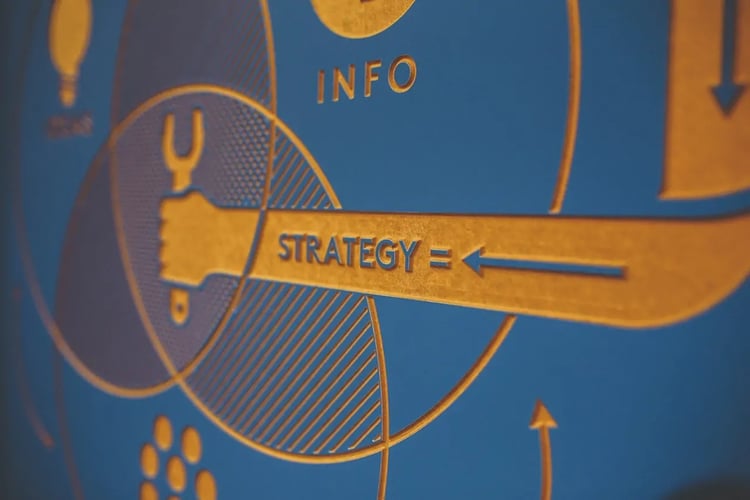According to business strategy experts Robert S. Kaplan and David P. Norton, 90% of companies fail to successfully execute their strategic plans. Even if a portion of their plans are effective, this stark failure rate causes many businesses to fall short of their goals year after year and be unable to accurately predict their performance.
Most leadership teams fail at planning because they spend too much time engaged in visionary brainstorming and not enough time mapping out projects and problem-solving.
In this article we’ll dive into the top 6 mistakes leaders make when strategic planning and how to avoid them so that you can create a strategic plan that’s predictive, actionable and inspiring.
1) Setting Too Many Goals
Any visionary leadership team has tons of ideas to improve their business. However, trying to incorporate all of them in your strategic plan is a recipe for failure because:
- It makes employees confused about what projects are the biggest priority
- Resources become stretched too thin
- Employees burnout because they’re pressured to do too many things
Teams who have several major goals often perform poorly since they don’t have the time to complete any single project well enough to make a meaningful impact.
To set your team up for success, choose 3-5 major goals for the year and 4-5 major projects per quarter that will enable you to achieve those goals. Narrowing down your plan to a few key goals enables everyone on your team to focus on the highest value activities.
2) Choosing the Wrong Metrics
Metrics are one of the most powerful drivers of employee behavior - especially if your team is held accountable for meeting challenging goals. Picking the wrong metrics or implementing metrics without context, can have a severe impact on your company culture and performance.
For example, if your sales reps’ primary metric the number of calls they have each month, they’re going to do whatever they can to hop on calls with as many prospects as they can without much regard for the prospects’ fit or how strong their pitch is.
They could have 150 calls a month but if they’re talking with people who are a bad fit and their pitches are weak, very few prospects will move forward to the next stage of the sales funnel and revenue will remain stagnant, if not decrease.
When setting metrics, you need to consider the end goal you’re trying to achieve and make sure your employees understand it.
Related: How to Set Effective Goals with Employees and Boost Performance
3) Not Accounting For Major Obstacles
Leaders often approach strategic planning with an abundance of optimism for the opportunities in the new year. Though some excitement is needed to set meaningful, ambitious goals, you can’t let it make you overlook to major barrier to success including:
- Your competitor recently launched a cheaper and/or more advanced product
- Resource shortages
- New industry regulations
- Internal conflicts that hinder productivity
And a variety of other obstacles that affect your organization’s ability to achieve its goals. Failing to account for these issues sets your team up for failure since they’ll underestimate the effort and resources required to achieve their goals.
Understanding the obstacles your organization faces shouldn’t stop you from setting ambitious goals. Instead, while you’re developing your strategic plan, you need to include strategies to address those issues so your teams are prepared to succeed.
4) Failing to Create an Execution Plan
Too often, leaders conclude strategic planning sessions excited about the goals they’re going to hit and the new initiatives they’re going to launch without any thought about how their goals are going to be executed. By the time they reassess their strategy a couple of quarters later, little progress has been made.
To ensure your planning sessions result in meaningful results, you need to spend just as much time, if not more, developing an execution plan.
Here are some tips to create a successful one:
- Involve your top-performers. They can provide valuable insights into what goals can be realistically achieved, what resources are required, and how long projects take.
- Debate what activities are most likely to drive your desired results. To ensure your team takes on the right projects, you need to come up with lots of ideas, pressure test them, and narrow your list to a few critical activities.
- Assign someone to be responsible for each project in your execution plan. Holding someone accountable dramatically increases the likelihood that you’ll see positive results.
Developing a strong execution plan will ensure your strategic planning drives meaningful change in your organization.
5) Ignoring Seasonality
Every industry has ebbs and flows, whether it’s due to national holidays, fiscal calendars, weather patterns, etc. that affect both sales and work attendance. Failing to take seasonality into consideration when you’re creating strategic plans often sets you up for failure since your goals will be far more difficult, if not impossible, to reach during certain times of the year.
The easiest way to understand how seasonality affects your business is to look at your monthly results from the last couple of years and look for any trends in the low and high months.
Once you know your strongest and weakest months, you can incorporate them into your strategic plan by using past metrics as baseline goals or allocating extra resources to your low months to minimize the impact of seasonal factors.
6) Setting Uninspiring, Unrealistic Goals
Often, leaders set goals purely based on their ideal financial projections. Though logical, this approach for developing strategic plans often fails since it doesn’t inspire excitement and commitment from your team.
According to the expectancy theory of psychology, people require two things to be motivated:
- They need to desire the reward or result that achieving a goal will yield
- They need to believe the goal is achievable
If you say your company-wide goal for the year is to increase net income by 30% and give each team a revenue-generating and/or cost-cutting goal to contribute to it, very few people are going to be motivated to achieve it.
However, if you give each team stretch goals that can be realistically achieved and explain the rewards they’ll get if they’re successful, your team will be highly motivated to implement your strategic plan.
Give Your Employees the Gift of Productivity
One of the most meaningful ways to show your employees you appreciate them is giving them more time to focus on the work they love. Learn how to give your employees the gift of productivity by checking out our free guide How to Give Your Team Leverage with Virtual Assistants. In it, you'll learn:
- What kinds of time-saving tasks your team can offload
- How we work with you to maximize the ROI of our service
- Our process for securely leveraging your systems
About the author: Emily formerly led Prialto's content production and distribution team with a special passion for helping people realize success. Her work and collaborations have appeared in Entrepreneur, Inc. and the Observer among others.

